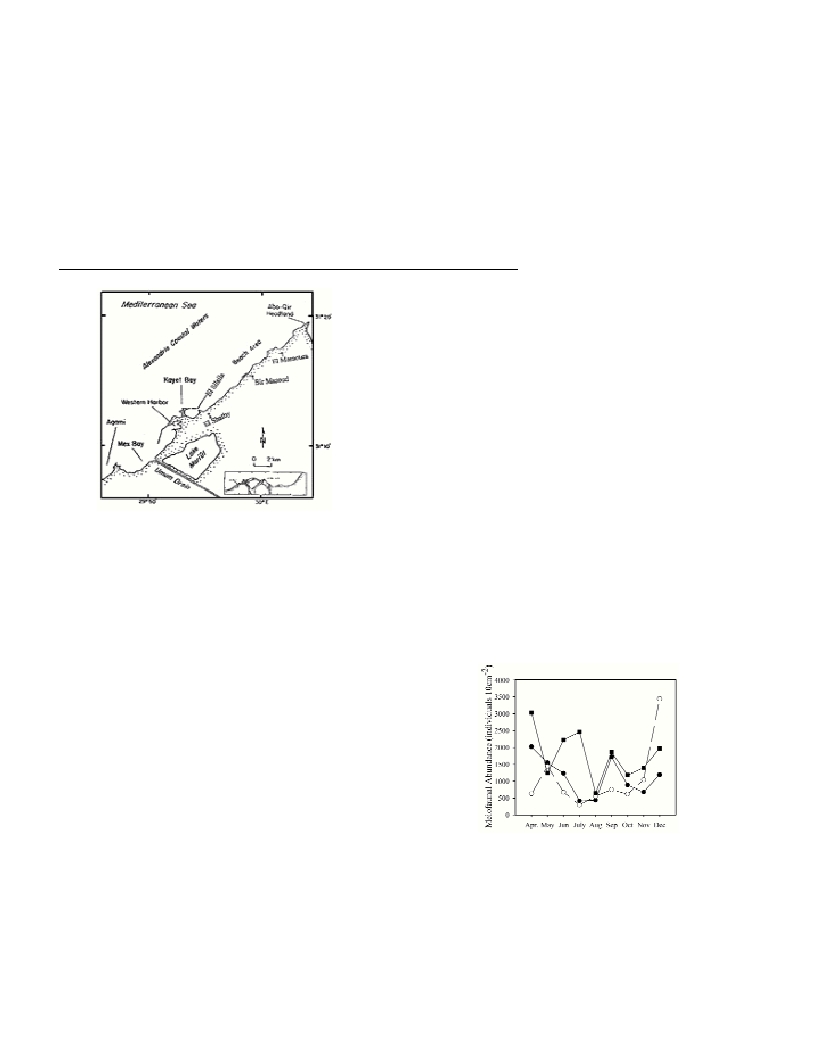EGYPTIAN SANDY BEACH MEIOFAUNA AND BENTHIC DIATOMS
Hanan Mitwally
1, 2
, Paul Montagna
1
, Youssef Halim
2 *
, Adel Ghani N. Khalil
2
,
Mohamed M. Dorgham
2
, and Manal M. Atta2
1
University of Alexandria, Faculty of Science, Oceanography Department, Egypt - * youssefhalim@hotmail.com
2
University of Texas at Austin, Marine Science Institute, Port Aransas, Texas, USA.
Abstract
Egyptian Mediterranean meiofauna has received limited attention until now. The earlier studies were qualitative rather than quantitative
(1, 2, 3). This first quantitative analysis of meiofauna along the Mediterranean coast of Alexandria, Egypt was carried out at three different
sandy beaches (El Mamoura E-M, Bir Masoud B-M, and El Shatby E-S) from April to December 1996. It was primarily aimed at a
comparative description of meiofaunal population abundances and composition in two habitats within each of three beaches.
Physicochemical factors (temperature, salinity, grain size, and total organic matter) and samples of suspected food (diatoms) were
measured in conjunction with meiofaunal samples from April to December 1996. At each survey, meiofaunal was sampled within two
habitats, supralittoral and intertidal to characterize within site variability at the three beaches (Fig.1).
Key words: Meiofauna; Alexandria; Egypt; Diatoms; Harpacticoida; Nematoda; grain size
Rapp. Comm. int. Mer Médit., 37,2004
537
The E-S beach which is intermittently exposed to waste water pollution
is differed from both E-M and B-M. The sea water temperature (SW
N
C)
varied from 29
N
C in July and 18
N
C in December. The sea water salinity
(SWl) and pore water salinity (PWl) separated E-M and B-M beaches
from E-S.
Overall mean PWl was 37.62l, 37.89l, and 36.55l respectively at E-M,
B-M, and E-S. The median grain size (N) at E-S showed medium coarse
sand especially in the intertidal habitat while at E-M and B-M was fine
grain sand. Overall mean N ranged between 2.00 (E-M and B-M) and 1.08
(E-S). The highest total organic matter (%TOM) was recorded twice at E-
S (1.25% in April) and at B-M (1.85% in July). Overall mean %TOM was
0.56% (E-M and B-M) and 0.63% (E-S).
Mean total meiofaunal abundances ranged from 2434 individuals
10cm
-2
at E-S, 1225 individuals 10cm
-2
at E-M, and 1083 individuals
10cm
-2
at B-M (Fig.2). They were more abundant in the supralittoral
than in the intertidal habitat. The communities comprised sixteen groups.
Seven were dominant averaging 98.1% overall (Ciliophora, Harpacticoida,
Nematoda, Archiannelida, Gastrotricha, Foraminifera, and Turbellaria).
Mean Harpacticoida abundances showed maxima in the moderately
warm months (spring-autumn) at all three beaches and minima during
summer. Eight interstitial and one phytal species were recorded. One
Cylindropsyllidae (Arenopontia nesaie), one new subspecies
Paramesochridae (Kliopsyllis constrictus egyptus), two new Ectino-
somatidae (Arenosetella bassantaeand Noodtiella toukae), one Ameiridae
(Nitocra spinipes), two Diosaccidae (Amphiascus parvusand Amphiascus
sp.), one Peltidiidae (Alteuthasp.), and one Tetragonicipitidae
(Phyllopodopsyllus pauli). Two new species and one new subspecies were
published separately (4).
Nematodes were analyzed to trophic guilds. Four different trophic
groups were distinguished (deposit feeders, epistrate, scavengers, and
predators)? Mean variance of deposit feeders and epistrate was lower at E-
S compared to E-M and B-M. Scavengers were higher at E-S. Predators
were different among beaches.
The abundance of benthic diatoms was high at E-M (ranging from 15
10
3
cells
-3
to 665 10
3
cells
-3
) and low at E-S (ranging from 2 10
3
cells
-3
to 11510
3
cells
-3
). Over the year and at all three beaches, the diatom
abundance sustained two peaks one during spring – summer and one in
winter.
To assess the importance of benthic diatoms as a food source for diffe-
rent meiofaunal groups, Principal Component Analysis (PCA) was done.
The data set consisted of factor scores resulting from the PC analyses on
diatom species data, PC analyses on Harpacticoida species, log transformed
total data of meiofauna, dominant meiofaunal groups data, and arcsine
transformed Nematode trophic groups data. This analysis was called “Biotic
analysis”. Results indicated that diatoms have a different relationship with
different meiofaunal groups especially with Harpacticoida, Archiannelida,
Foraminifera, Ciliophora, Turbellaria, and Nematoda. This relationship
differs in sign and magnitude.
To illustrate typical associations of organism groups in relation to their
physical environment,
Another PCA analysis was performed. The data set of the Biotic
analysis was used after merging with the square root-root transformed data
of %TOM, PWl, N, SW
N
C, sorting , and log transformed SWl. This
analysis was named “Biotic and abiotic analysis”.Results revealed that,
on PC2 all the biotic variables loaded negatively, while all abiotic
variables loaded positively. On PC1, Hapacticoida, meiofauna, predators,
and scavengers loaded negatively. In contrast, diatoms, epistrate, deposit
feeders, N, PWl, SW l, and SW
N
C loaded positively on PC1. The relation
between biotic and abiotic variables was generally negative.
The biotic and abiotic analyses were used to differentiate among
beaches. The E-S beach was different from E-M and B-M which were
similar. The E-M and B-M beaches were similar with high abundance of
diatoms and high percentage composition of nematode deposit feeders and
epistarte. Their pore and sea water salinity and their grain size were also
higher. In contrast, E-S beach which is downstream from effluent had
higher grain size, lower salinity, and its %TOM was 0.1% higher. It was
occupied by a higher abundance of meiofauna and Harpacticoida, and a
high predators and scavenger’s percentage.
References
1-Gurney. R., 1927. Report on the Crustacea-Copepoda (littoral and semi
parasitic). Zoological results of the Cambridge expedition to the Suez
Canal, 1924. No., 35. Trans Zool. Soc. Lond., 22:451-577, figs. 108-168.
2-Steuer. A., 1943. Variablitat und Verbreitung einiger Copepoda
Harpacticoida der Gattungen America und Mesochraaus dem-stlichen
Mittelmeer (Alexandria). Thalassia,6:1-19.
3-Remane, A., and E. Schulz, 1964. WissenSchaftliche Ergebnisse einer
Forschungsreise von Adolf Remane und Eric Shultz nach dem Roten
Meer. 169 p.
4-Mitwally, H., and P.A. Montagna, 2001. Egyptian interstitial Copepda
Harpacticoida with the description of two new species and one new
subspecies. Crustaceana. 74 (6):513-544.

